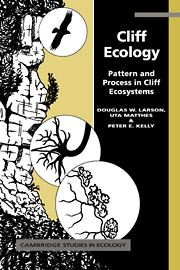5 - Fauna
Published online by Cambridge University Press: 16 September 2009
Summary
Cliffs worldwide support a variety of protists and animals including a vast array of invertebrates, amphibians, reptiles, birds and mammals. Cliffs in one area of highland in southern British Columbia, Canada, for example, supported 41 per cent (22 of 54) of the faunal species of high conservation value for the region (Sinnemann, 1992). Most studies of cliff fauna, however, have focused on one or a small number of species. This is in striking contrast to the floristic studies reviewed in the last chapter that generally focused on the determination of the composition of the entire plant community. In most faunal studies, the focus of the research is usually not on the habitat but rather directly on the species that occur there. Exceptions to this trend in the faunal literature include Johnson (1986), Reitan (1986), Ward and Anderson (1988), and Camp and Knight (1997). As a result, the organization of this chapter is quite different from the preceding one. This chapter summarizes the information that is presently available in the scientific literature on the ecology and distribution of faunal cliff species and presents it in broad taxonomic groups.
Avifauna
General trends
Cliffs appear to support a greater species richness of birds than equal areas within the surrounding habitat, although not all of these birds nest on the cliffs. This difference between adjacent land and cliffs is partly attributable to cliffs being ‘permanent habitat edges’ characterized by abrupt changes in soil, topography, geomorphology and microclimate combined with local conditions that minimize interspecific competition and predation (Matheson & Larson, 1998).
- Type
- Chapter
- Information
- Cliff EcologyPattern and Process in Cliff Ecosystems, pp. 125 - 174Publisher: Cambridge University PressPrint publication year: 2000

